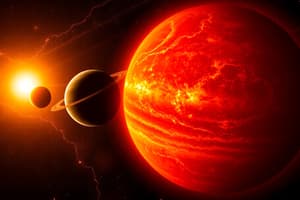Podcast
Questions and Answers
What happens to the emitted energy when the temperature of an object is doubled?
What happens to the emitted energy when the temperature of an object is doubled?
- It increases by 16 times. (correct)
- It doubles.
- It quadruples.
- It remains the same.
Which type of radiation is maximized at approximately 10 microns?
Which type of radiation is maximized at approximately 10 microns?
- Visible Light
- Infrared Radiation (correct)
- Ultraviolet Radiation
- X-Rays
How does the wavelength of radiation relate to its energy?
How does the wavelength of radiation relate to its energy?
- Longer wavelengths indicate higher energy.
- Shorter wavelengths have higher energy. (correct)
- Shorter wavelengths have lower energy.
- Wavelength does not affect energy.
According to Wien's Law, how does the temperature of an object affect the wavelength of emitted radiation?
According to Wien's Law, how does the temperature of an object affect the wavelength of emitted radiation?
What characterizes radiation transfer from the sun to Earth?
What characterizes radiation transfer from the sun to Earth?
What is primarily responsible for the sun's heat and energy output?
What is primarily responsible for the sun's heat and energy output?
What is the approximate temperature of the sun's core?
What is the approximate temperature of the sun's core?
What phenomenon occurs due to cooler regions caused by the sun's magnetic fields?
What phenomenon occurs due to cooler regions caused by the sun's magnetic fields?
Which of the following describes a coronal mass ejection (CME)?
Which of the following describes a coronal mass ejection (CME)?
How long does it generally take for solar plasma to reach Earth?
How long does it generally take for solar plasma to reach Earth?
Which layer of the sun is primarily composed of unburned hydrogen?
Which layer of the sun is primarily composed of unburned hydrogen?
What can be a result of solar plasma interacting with Earth's atmosphere?
What can be a result of solar plasma interacting with Earth's atmosphere?
Which of the following is an effect of solar plasma on electronic devices?
Which of the following is an effect of solar plasma on electronic devices?
Flashcards are hidden until you start studying
Study Notes
Introduction to the Sun
- The sun is the cornerstone of Earth's climate; without it, Earth would be lifeless.
- Its distance from the Earth is 93 million miles (approximately 150 million kilometers).
- The sun formed about 4.6 billion years ago, a well-established scientific fact.
- Hydrogen nuclei fusion produces helium and emits heat energy in the sun's core.
Structure and Composition of the Sun
- The sun's core reaches temperatures of 15.6 million Kelvin with immense pressure.
- The surface temperature is about 6,000 Kelvin.
- The sun predominantly consists of unburned hydrogen with helium as a byproduct of fusion.
Solar Phenomena
- Plasma: A state of matter formed in the sun's core due to extreme temperatures and pressures, creating charged particles.
- Sunspots: Cooler regions (approximately 4,500 Kelvin) caused by the sun’s magnetic fields.
- Solar Flares: Explosive bursts of energy and plasma due to magnetic irregularities.
- Coronal Mass Ejections (CMEs): Massive plasma eruptions that can impact Earth, with sizes significantly larger than the planet itself.
Mathematical Understanding of Solar Plasma Arrival
- Solar plasma travels at about 3 million kilometers per hour.
- It takes approximately 50 hours for solar plasma to reach Earth, using the formula time = distance/velocity.
- During intense CMEs, plasma may reach Earth in about 24 hours.
Effects of Solar Plasma on Earth
- The Earth's magnetic field, or magnetosphere, protects against solar plasma.
- Auroras: Beautiful light displays near the poles caused by solar plasma interaction with the atmosphere.
- Electronic Disruptions: Solar plasma can interfere with electronic devices, causing failures in satellites and communication systems.
- Historical power outages occurred due to solar events, such as the 1989 Quebec blackout affecting six million people.
Radiation from the Sun
- The sun continuously emits radiant energy as a byproduct of fusion.
- Conduction and Convection: Other methods of heat transfer; however, radiation is the primary method from the sun to Earth.
- Electromagnetic Spectrum: Ranges from radio waves to gamma rays; all radiation travels at the speed of light (approx. 300 million meters per second).
Wavelength and Energy Characteristics
- Wavelength, symbolized by lambda (λ), is critical in identifying radiation types.
- Shorter wavelengths have higher energy; examples include ultraviolet and x-rays.
- Stefan-Boltzmann Law: Warmer objects emit radiation more intensely. Doubling the temperature increases emitted energy by 16 times.
- Wien's Law: Warmer objects emit radiation at shorter wavelengths.
Comparison of Solar and Earth Radiation
- The sun's average surface temperature (6,000 Kelvin) emits radiation maximized at 0.5 microns (yellow light).
- Earth emits radiation maximized at approximately 10 microns (infrared), critical for understanding climate livability.
Introduction to the Sun
- The sun is essential for Earth's climate and life; absence would render Earth uninhabitable.
- Distance to the sun is approximately 93 million miles (150 million kilometers).
- Formed around 4.6 billion years ago, its origin is a well-accepted scientific consensus.
- The core generates energy through hydrogen fusion, converting it into helium.
Structure and Composition of the Sun
- Core temperature reaches about 15.6 million Kelvin, with extreme pressure conditions.
- Surface temperature hovers around 6,000 Kelvin, characterizing its outer layer.
- Primarily composed of unburned hydrogen; helium is a byproduct of the fusion process.
Solar Phenomena
- Plasma: A charged particle state resulting from high temperatures and pressures in the sun's core.
- Sunspots: Relatively cooler regions at around 4,500 Kelvin, caused by magnetic field effects.
- Solar Flares: Energy and plasma bursts generated by magnetic disruptions on the sun's surface.
- Coronal Mass Ejections (CMEs): Huge plasma eruptions that can extend far beyond the sun and affect Earth significantly.
Mathematical Understanding of Solar Plasma Arrival
- Solar plasma travels at speeds close to 3 million kilometers per hour.
- It takes about 50 hours for solar plasma to reach Earth, calculated via the formula: time = distance/velocity.
- Intense CMEs can shorten this travel time to roughly 24 hours.
Effects of Solar Plasma on Earth
- Earth's magnetosphere acts as a shield against harmful solar plasma.
- Auroras: Stunning displays of light near the poles result from solar plasma interacting with the atmosphere.
- Electronic Disruptions: Solar plasma can disrupt satellite operations and communication systems.
- Historical impacts include the 1989 Quebec blackout, which left six million people without power.
Radiation from the Sun
- Continuous emission of radiant energy occurs as a byproduct of ongoing nuclear fusion.
- Conduction and Convection: Other heat transfer methods exist but are secondary to radiation from the sun to Earth.
- Electromagnetic Spectrum: Includes all radiation types from radio waves to gamma rays, traveling at light speed (approximately 300 million meters per second).
Wavelength and Energy Characteristics
- Wavelength, denoted by lambda (λ), is crucial for categorizing different types of radiation.
- Short wavelengths correlate with higher energy; ultraviolet and x-rays serve as prime examples.
- Stefan-Boltzmann Law: Indicates that doubling an object's temperature results in a 16-fold increase in emitted energy.
- Wien's Law: Suggests that warmer bodies emit radiation at shorter wavelengths.
Comparison of Solar and Earth Radiation
- The sun radiates at an average surface temperature of 6,000 Kelvin, peaking at 0.5 microns (yellow light).
- Earth’s radiation peaks around 10 microns (infrared), essential for maintaining climate stability and livability.
Studying That Suits You
Use AI to generate personalized quizzes and flashcards to suit your learning preferences.




